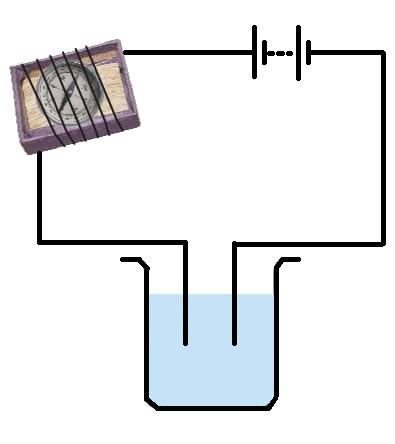
When the free ends of a tester are dipped into a solution, the magnetic needle shows deflection. Can you explain the reason?
Answer
592.5k+ views
Hint: Ampere’s law helps in relating the integrated magnetic field around a closed loop or a coil to the electric current passing through the loop. According to Einstein’s theory electric current can also be produced by varying magnetic fields.
Complete step by step answer:
When an electric charge is in motion, magnetic lines of force rotate around the particle. Since electrical current passing through a wire consists of electrons in continuous motion, there is a magnetic field around the wire. This magnetic field can be demonstrated by placing some fine iron filings or shavings on a card and sticking a wire through the middle of the card. When a DC current is passed through the wire, the iron filings align to show the magnetic field. Iron filings show magnetic fields around electric wire. When an electric charge is moving or an electric current passes through a wire, a circular magnetic field is created.
We are given that the free ends of a tester are dipped into a solution, and the magnetic needle shows deflection.

Solution has ions present in it causing the generation of electric current. Electric current produces magnetic effect. When free ends of a tester are dipped in the solution, the solution conducts electricity as it is a good conductor of electricity. So, the circuit is now complete. Hence, electricity passes through the wire causing deflection of the magnetic needle of a compass.
Note: Electric current passing through a wire can result in the generation of magnetic fields. Strength of the magnetic field depends on the strength or amount of electric current. The more current flowing through the wire, the stronger the intensity of the magnetic field. We can also say that a varying electric field produces a magnetic field and a varying magnetic field produces an electric field.
Complete step by step answer:
When an electric charge is in motion, magnetic lines of force rotate around the particle. Since electrical current passing through a wire consists of electrons in continuous motion, there is a magnetic field around the wire. This magnetic field can be demonstrated by placing some fine iron filings or shavings on a card and sticking a wire through the middle of the card. When a DC current is passed through the wire, the iron filings align to show the magnetic field. Iron filings show magnetic fields around electric wire. When an electric charge is moving or an electric current passes through a wire, a circular magnetic field is created.
We are given that the free ends of a tester are dipped into a solution, and the magnetic needle shows deflection.

Solution has ions present in it causing the generation of electric current. Electric current produces magnetic effect. When free ends of a tester are dipped in the solution, the solution conducts electricity as it is a good conductor of electricity. So, the circuit is now complete. Hence, electricity passes through the wire causing deflection of the magnetic needle of a compass.
Note: Electric current passing through a wire can result in the generation of magnetic fields. Strength of the magnetic field depends on the strength or amount of electric current. The more current flowing through the wire, the stronger the intensity of the magnetic field. We can also say that a varying electric field produces a magnetic field and a varying magnetic field produces an electric field.
Recently Updated Pages
Master Class 8 Science: Engaging Questions & Answers for Success

Master Class 8 Maths: Engaging Questions & Answers for Success

Master Class 8 English: Engaging Questions & Answers for Success

Master Class 8 Social Science: Engaging Questions & Answers for Success

Class 8 Question and Answer - Your Ultimate Solutions Guide

Questions & Answers - Ask your doubts

Trending doubts
What is BLO What is the full form of BLO class 8 social science CBSE

What are the 12 elements of nature class 8 chemistry CBSE

Give me the opposite gender of Duck class 8 english CBSE

Application to your principal for the character ce class 8 english CBSE

Full form of STD, ISD and PCO

Citizens of India can vote at the age of A 18 years class 8 social science CBSE




